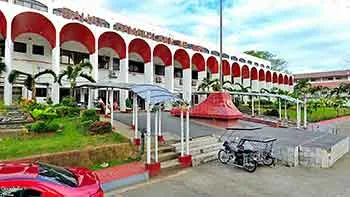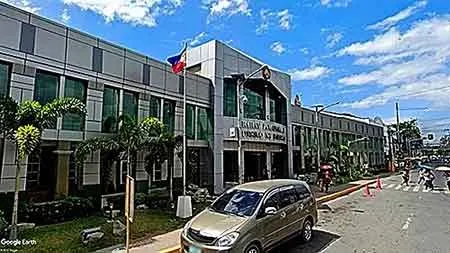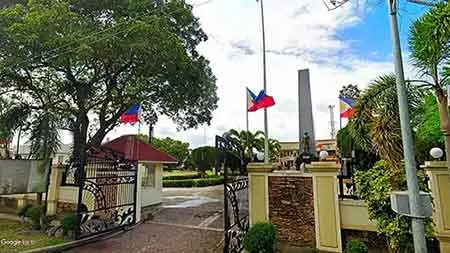Batangas is one of eighty-one (81) provinces of the Republic of the Philippines. It is located at the southern end of the large island of Luzon, its northern borders just short of sixty (60) kilometers as the crow flies from the country’s capital city of Manila. It has a land area of 3.1105.5 square kilometers or 1,202.73 square miles1, presently (June 2022) divided into thirty (29) municipalities and five (cities).
The Province of Batangas’ newest city is Calaca, the cityhood of which was formally proclaimed by the Commission on Elections after a special plebiscite conducted within the former municipality on the 3rd of September 2022. In the plebiscite, citizens of Calaca overwhelmingly approved the conversion of the municipality into a city. The final tally was 29,424 yes votes against 3,781 no votes.
Lipa City
 |
| The Lipa City Hall. Image courtesy of Google Earth Street View. |
Lipa is the first and, thus, oldest city in Batangas. Its cityhood was confirmed after the approval of Republic Act Number 162 on the 20
th of June 1947
2. Lipa is a first-class component city with a land area of 20,940 hectares. This city is presently the most populous geo-political unit in the province, first overtaking Batangas City in this regard after the results of the
2015 Philippine Population Census were published. As of the 2020 Philippine Census, the city’s total population has grown to 372,931. The city has a total of seventy-two (72) barrios or barangays, a complete list of which may be found here:
Complete List of Barangays in Batangas Province3.
Batangas City
 |
| Batangas City Hall. Image courtesy of Google Earth Street View. |
The City of Batangas, which took over from the Municipality of Taal as the capital of the Province of Batangas after the cataclysmic 1754 eruption of Taal Volcano, became the province’s second city after the approval on 21 June 1969 of Republic Act Number 5495
4. This act, otherwise known as the “Charter of Batangas City,” formally converted the erstwhile Municipality of Batangas into a city. Batangas City has the largest territory among all geo-political units of the province, with a total of 28,541 hectares. Its 2020 population was placed at 351,437, second highest behind Lipa City. The city has a total of one hundred and five (105) barrios or barangays, a complete list of which may be found here:
Complete List of Barangays in Batangas Province5.
Tanauan City
 |
| The Tanauan City Hall. Image courtesy of Google Earth Street View. |
Tanauan became the Province of Batangas’ third city after the approval on 2 February 2001 of Republic Act No. 9005, otherwise known as the Charter of the City of Tanauan
6. It is classified as a second-class city in terms of income. Tanauan is also a component city with a land area of 10,716 hectares, which is just eleventh in the entire province. Its population has burgeoned in the past decade or so, rising from 152,393 in the 2010 census, to 173,366 in the census of 2015, and finally to 193,936 in the 2020 count. This last number placed Tanauan as the fourth most populous geo-political unit of the province. The city has a total of forty-eight (48) barrios or barangays, a complete list of which may be found here:
Complete List of Barangays in Batangas Province7.
Santo Tomas City
 |
| The Santo Tomas City Hall. Image courtesy of Google Earth Street View. |
The fourth city of the Province of Batangas is Santo Tomas. Its cityhood became official after the approval on 5 October 2018 of Republic Act No. 11086, otherwise known as the Charter of the City of Santo Tomas
8. This city is the smallest in the entire province in terms of territory, with just 9,367 hectares, which makes it just twelfth among all geo-political units of Batangas. Despite this, probably because of its relative proximity to Metro Manila, Santo Tomas is actually significantly more populous than Tanauan City. Its population in 2010 was a “mere” 124,740. This shot up to 179,844 in 2015 and finally 218,500 after the 2020 Philippine Census. This last number places Santo Tomas as the provinces third most populous geo-political center. The city has a total of thirty (30) barrios or barangays, a complete list of which may be found here:
Complete List of Barangays in Batangas Province9.
Calaca City
 |
| The Calaca Municipal (soon-to-be City) Hall. Image courtesy of Google Earth Street View. |
The cityhood of the former Municipality of Calaca, courtesy of Republic Act No. 11544, otherwise known as the Charter of the City of Calaca, was signed into law on 26 May 2021 by President Rodrigo Duterte
10. For this law to come into effect, a plebiscite among the citizens of Calaca had to be conducted. However, in August of 2021, the Commission on Elections issued Resolution No. 10716 postponing this and other plebiscites until after the holding of the 2022 National and Local Elections
11. The plebiscite was finally held on the 3
rd of September 2022. Citizens of the former municipality braved bad weather to formally ratify RA 11544. The final tally was 29,424 yes votes and just 3,781 no votes. That same day, after the results had been counted, the Commission on Elections formally declared Calaca as a component city of the Province of Batangas. Calaca is relatively underpopulated as compared to Batangas’ four other cities, with just 87,361 in 2020. This is just eleventh in the entire province. In fact, the towns of Nasugbu, Rosario, San Juan, Balayan, Lemery and Bauan are more populous than Calaca. This city has a total of forty (40) barrios or barangays, a complete list of which may be found here:
Complete List of Barangays in Batangas Province12.
Notes and references:
1 “Batangas,” online at Philatlas.com.
2 “Republic Act Number 162,” online at LawPhil.net.
3 General information about Lipa City obtained from the web sites of the Department of the Interior and Local Government (DILG) and the Philippine Statistics Authority (PSA).
4 “Republic Act Number 5495,” online at LawPhil.net.
5 General information about Batangas City obtained from the web sites of the DILG and the PSA.
6 “Republic Act Number 9005,” online at LawPhil.net.
7 General information about Tanauan City from the web sites of the DILG and the PSA.
8 “Republic Act Number 11086,” online at LawPhil.net.
9 General information about Santo Tomas City from the web sites of the DILG and the PSA.
10 “Republic Act Number 11544,” online at LawPhil.net.
11 “Comelec postpones 5 plebiscites to prepare for May 2022 polls,” by Ferdinand Patinio, published 19 August 2021, online at the Philippine News Agency.
12 General information about Santo Tomas City from the web sites of the DILG and the PSA.





